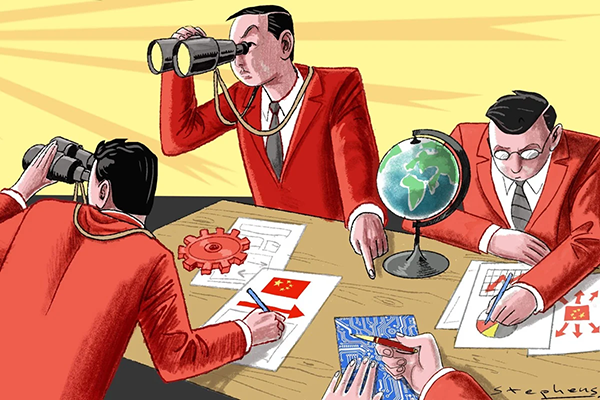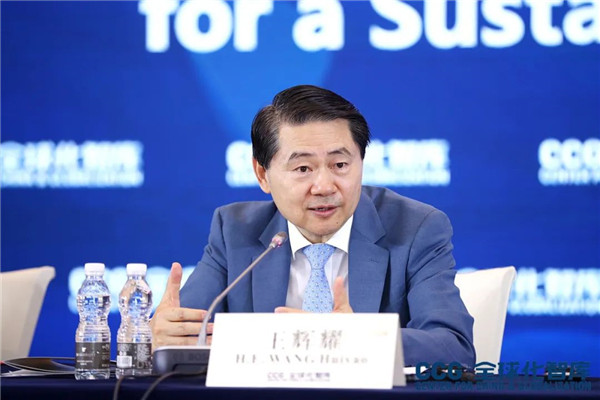BRI’s role as global public good should be maximized
China Daily | October 12 , 2023 Containers are loaded onto a cargo vessel in Qinzhou Port, Guangxi Zhuang autonomous region, a transit point on the New International Land-Sea Trade Corridor. [PHOTO/XINHUA]
Containers are loaded onto a cargo vessel in Qinzhou Port, Guangxi Zhuang autonomous region, a transit point on the New International Land-Sea Trade Corridor. [PHOTO/XINHUA]
China Daily OP-Ed
By Wang Huiyao | Founder of the Center for China and Globalization(CCG)
The Belt and Road Initiative has grown from a vision in 2013 to a series of bilateral arrangements today with the potential to serve as a global platform for international infrastructure development. By June 2023, 152 countries and 32 international organizations had signed more than 200 cooperation agreements with China on Belt and Road cooperation, reflecting the popularity and effectiveness of the initiative.
But despite being praised by many countries in Southeast Asia, Eastern Europe, Africa and the Middle East, the initiative is still yet to convince some Western countries about its crucial role in cross-border infrastructure development. There are multiple reasons for that, but in general, the Belt and Road Initiative faces three main challenges.
Negative reports cause of misunderstandings
The first challenge is in terms of the power of discourse. Given the relatively weak voice of the Chinese media in international circles and consequently their limited influence, Western media outlets are able to influence the international community’s views on the initiative to a greater extent. Also, negative reports on Belt and Road-related issues cause misunderstandings and negatively impact the initiative.
The second challenge is the Westfloated notion that the Belt and Road Initiative creates “debt traps” for developing countries. Many scholars around the world have studied this issue and have proven that the initiative does not create “debt traps”. Yet some Western observers and media outlets continue to trumpet their baseless claims.
And third, the initiative means different things for different countries and observers, which means it lacks a unified definition.
To enhance its inclusiveness, China should ensure the Belt and Road Initiative widens its cooperation with other international mechanisms, so as to integrate itself with the global cooperation networks and project itself as a crucial international platform to serve not only China but the rest of the world.
Broad consensus needed to enhance interaction
Given these facts, the Belt and Road Initiative should build a broad consensus with its overseas participants to facilitate closer interaction with the international community. To “multilateralize” the Belt and Road Initiative, I’d suggest the authorities establish the following mechanisms.
To begin with, multilateral decision-making structures could be built to strengthen the Belt and Road Initiative and ensure high-quality infrastructure development. If the countries involved in the initiative were offered and do accept the responsibility of jointly building the multilateral structures, a new institution, say a Belt and Road International Steering Committee or Belt and Road International Cooperation Organization, could be established. Invited countries could send their representatives to participate in the committee or organization, and help form a new order of global and regional governance for the initiative.
An apt example of such an organization is the ASEAN China Center, established by China and ASEAN member states, which serves as a regional institution with offices in China and ASEAN member states. It has an efficient three-tier management, which provides guidance and undertakes specific tasks in the alignment and cooperation of major bilateral and multilateral policies with relevant countries.
A BRI steering committee mechanism could also be aligned with the existing multilateral institutions of global and regional governance such as the G20 and the Asia-Pacific Economic Cooperation forum. This would allow countries to regularly meet and discuss Belt and Road-related agenda items and carry out extensive exchanges and consultations. The agreements, plans, mechanisms and projects jointly implemented would boost the development of Belt and Road projects.
Second, the Belt and Road Initiative could engage with international organizations under the United Nations framework to invite them to participate in Belt and Road projects. The initiative could also request the United Nations to establish a Belt and Road cooperation mechanism, giving full play to the UN’s best practices and its role as a bridge between countries.
The UN’s involvement in the Belt and Road Initiative could help establish working relationships with UN agencies such as the United Nations Development Programme and the World Trade Organization. While the support of the UN would give additional confidence to Belt and Road countries, getting the UN’s support may be difficult as the United States and certain other countries are likely to block UN agencies from associating with the Belt and Road Initiative. So China needs to tread this path with caution.
Third, China should take measures to engage more developed economies in Belt and Road third-party market cooperation and expand its cooperation with the US and the European Union in infrastructure construction projects. China has already signed cooperation agreements with France and Japan for projects in third-party markets. Such agreements could be expanded to other developed countries. Third-party market cooperation agreements emphasize complementarities, which include China’s high-level production capacity, advanced technology from developed countries and the infrastructure needs of developing countries. Bringing these together will provide a new model for high-quality joint cooperation on Belt and Road projects and promote multilateralism.
China could also consider proposing infrastructure cooperation between the Belt and Road Initiative, the EU’s Global Gateway and the US’ Build Back Better infrastructure initiatives. Also, the India-Middle East-Europe Economic Corridor proposed at the G20 Summit in New Delhi raises the possibility of building a China-US-India-Europe “quadrilateral+” platform for global infrastructure investment and development.
The Organization for Economic Co-operation and Development, an organization of industrialized economies, which promotes the economic health of its members and contributes to worldwide development, also compares policy experiences, identifies good practices and coordinates domestic and international policies of its members. It could thus be used as a model to “multilateralize” the Belt and Road Initiative.
Advanced economies should ease doubts on BRI
Fourth, expanding the Asian Infrastructure Investment Bank’s target sectors and regions could be a plausible way of providing support for eligible infrastructure investment projects worldwide. And China could explore the possibility of establishing an international development bank cooperation partnership to boost collaboration among various international development banks.
The partnership among international and regional development banks such as the World Bank, Asian Development Bank, African Development Bank, Latin American Development Bank, European Bank for Reconstruction and Development, Islamic Development Bank and the AIIB will bolster inter-banking coordination, help improve infrastructure in developing countries, build digital infrastructure and enable green transition.
While there are funding gaps, infrastructure spending tends to spur investment demand and create jobs. So long as the global geopolitical environment allows, the arrangement could form an international, standardized, open and transparent infrastructure development system and expand supply networks for global products.
And sixth, the Belt and Road Initiative should consider mobilizing the business resources as well as think tanks worldwide to explore more intellectual resources. Establishing a Belt and Road international business partnership and creating a multi-tiered and diversified think tank platform would help introduce dynamics to people-to-people communication and mutual understanding. By organizing non-official international forums and summits, these partnerships can enrich and diversity the Belt and Road Initiative and turn it into a popular international initiative.
In conclusion, China could work to improve global economic governance. China can further increase its public participation level, and more staunchly uphold multilateralism. This would help maximize the role of the initiative as a global public good.
From China Daily, 2023-10-12
Recommended Articles
-

Wang Huiyao: Key lessons from China’s ascent over the past 25 years
-
Wang Huiyao: China and Latin America: Partners in a shared new era
-
Wang Huiyao: Only a multipolar coalition can secure Ukraine peace
-
Wang Huiyao: How to Fix the Security Council
-
Wang Huiyao: Critics are missing the big picture on China’s economic transition
